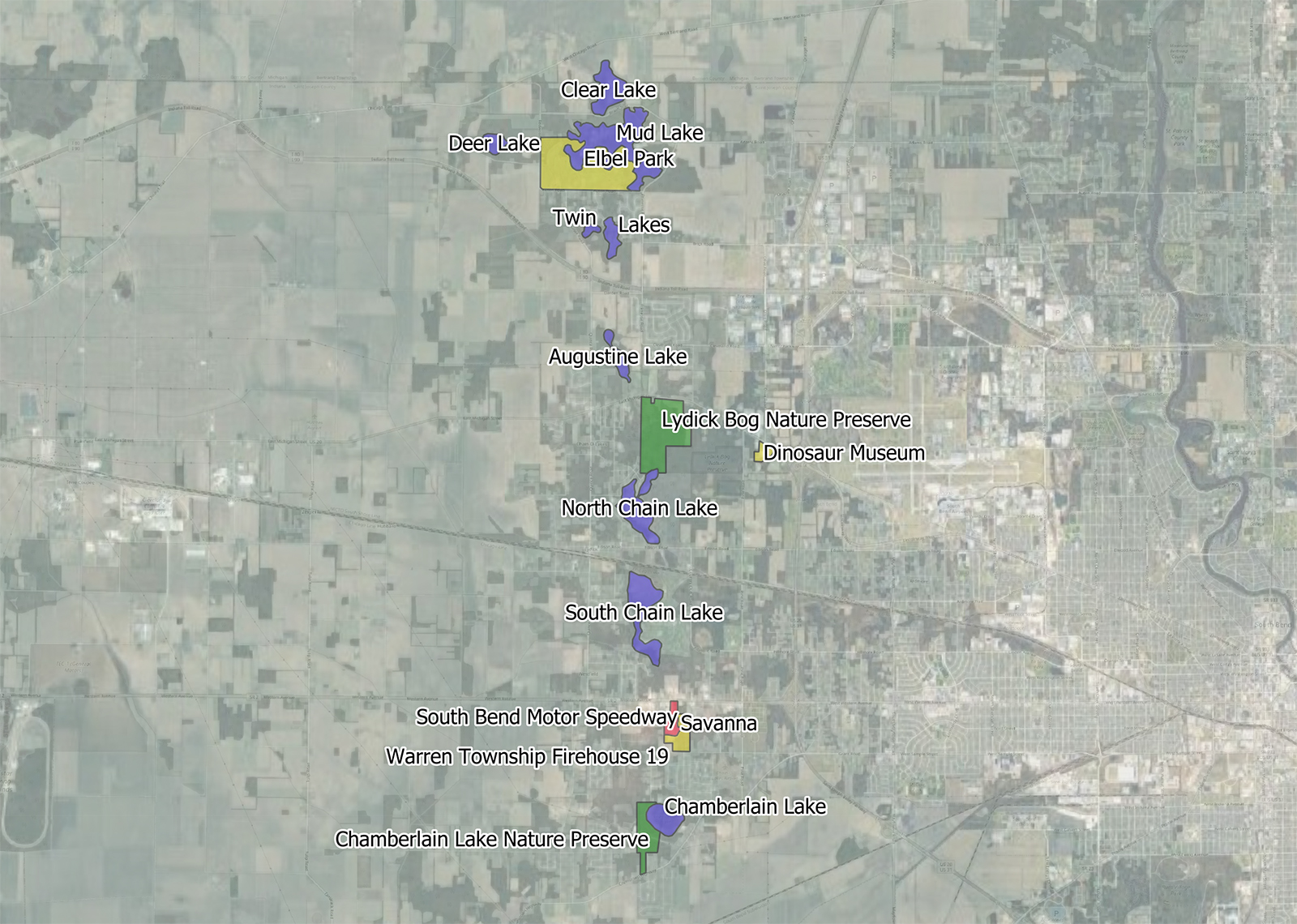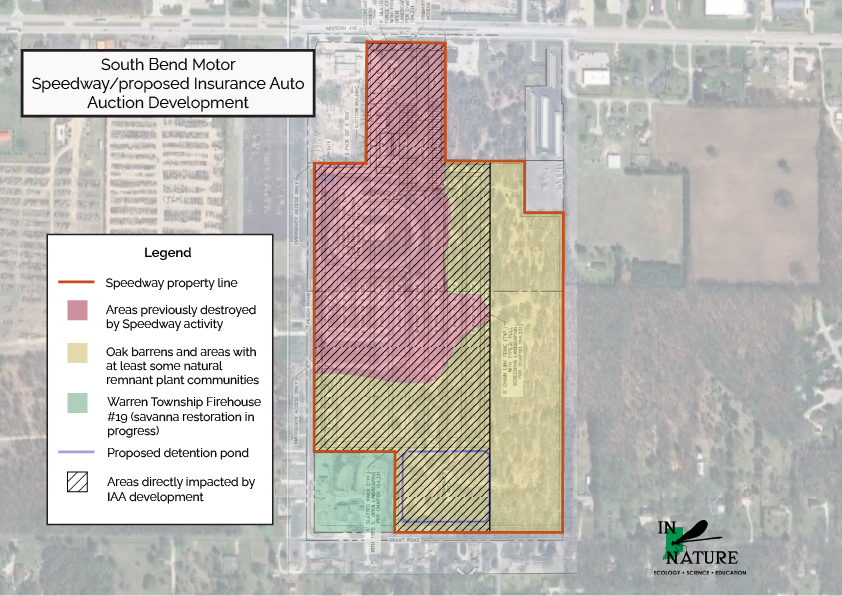ECOLOGY ▪ EDUCATION ▪ ADVOCACY
The South Bend Motor Speedway savanna is an approximately 34-acre remnant oak savanna located immediately east and south of the South Bend Motor Speedway, approximately two miles west of South Bend in St. Joseph County’s Warren Township, near the intersection of SR2 and Peach Road. Although the savanna is part of the speedway property, it has remained undeveloped.

An oak savanna is a transitional ecosystem between a prairie or grassland and a forest. Unlike forests, oak savannas have a relatively open canopy, which allows light to penetrate to the ground, thus allowing for a range of sun-loving understory and ground-level flowering plants and their associated fauna to thrive. Following the classification provided by Michigan State University, the speedway savanna is technically an “oak barren,” a fire-dependent type of savanna dominated by a black oak (Quercus velutina) and white oak (Q. alba) canopy.
According to the United States Department of Agriculture, oak savanna ecosystems are “among the most threatened in the world,” with “less than .01% remaining.” The National Park Service calls oak savannas “unique and endangered” and estimates that only 30,000 of the original 50 million acres of Midwestern oak savanna remain. Michigan State Univesity ranks oak barrens “globally imperiled.” In St. Joseph County, the speedway savanna represents perhaps the county's last remaining sizable remnant.
Among those who were vocal in support of the protection of the savanna was the renowned regional botanist Keith Board. After “discovering” the site in 1993, Board went on to catalog over 85 species of native plants growing there, including some with high conservation values, such as cream wild indigo (Baptisia leucophaea), early oak sedge (Carex umbellata), hairy bedstraw (Galium pilosum), box huckleberry (Gaylussacia baccata), western sunflower (Helianthus occidentalis), purple milkwort (Polygala polygama obtusata), small wild bean (Strophostyles leiosperma), and others. Board continued to advocate for the permanent preservation of the property until his passing in 2019.
In addition to plants, the property supports an impressive array of breeding season birds, including Field, Savanna, Song and Vesper Sparrows, Killdeer, American Goldfinches, Eastern Bluebirds, Wild Turkeys and Eastern Towhees. Red-tailed and Red-shouldered Hawks are frequently sighted, and for at least the past two years, a pair of Osprey, an Indiana Species of Special Concern, have nested atop one of the speedway's light towers.

The South Bend Motor Speedway savanna is part of the same geological system that created the county’s western kettle lakes region. Beginning at the Michigan state line and extending through Crumstown, the area contains nine lakes, a bog, two state-dedicated nature preserves, a city park, and a dinosaur museum. The Kankakee River begins its journey to the Gulf of Mexico here, and the corridor is home to dozens of endangered, threatened, rare, and “special concern” plant and animal species. Thousands of visitors hike the miles of trails at Lydick Bog and Chamberlain Lake Nature Preserves, golf at Elbel Park and the South Bend Country Club, boat and fish on North Chain Lake, and maybe catch glimpses of breeding Bald Eagles, Osprey, and Sandhill Cranes, all birds making historical comebacks after decades of decline.
Even given all of the quality natural areas in the Kettle Lakes region, no other property in the system contains the unique qualities of the speedway savanna. The glaciers left behind sandy soils and a habitat containing plants like prickly pear cactus (Opuntia humifusa), sand milkweed (Asclepias amplexicaulis), sand coreopsis (Coreopsis lanceolata), and New Jersey tea (Ceanothus americanus); species more reminiscent of the Indiana Dunes than to St. Joseph County.

In 2023, the Warren Township Fire Department constructed a new firehouse on five acres of subdivided speedway property at the corner of Grant and Peach Roads. As conscious ecological stewards, the township planted exotic turf grass only along a small portion of the front entrance and dedicated the rest to a restorative savanna landscape. Not only is over 97% of the landscape planted with native plants, but the species selected reflect those historically present at the site, and many returned on their own or were grown from collected seed. The resulting landscape will blend (both aesthetically and ecologically) into the adjacent savanna, and the firehouse property includes a walking trail where the firefighters benefit physically and mentally through immersion in nature. The firefightes have taken to the ecology of their new station so much that they have dubbed it “The Cactus Ranch”
The owners of the South Bend Motor Speedway recently agreed to sell the entirety of the property, including the black oak savanna, to Insurance Auto Auctions, contingent upon rezoning. The conceptual design submitted to the county calls for destroying much of the savanna to make way for automobile stalls and a county-mandated detention pond. Should this project come to fruition, Hoosiers will mourn the loss of yet another remnant of Indiana's dwindling natural heritage.
What they are asking for:

At their September 17 meeting, to a packed house of around 100 people, the St. Joseph County Area Planning Commission heard from nearly 50 people speaking in opposition to the rezoning and special use permits, with none in favor. At the conclusion of the nearly three-hour meeting, the commissioners voted unanimously to send the petition to the county council with an “unfavorable recommendation.”
In addition to the impending destruction of the oak savanna, commission members heard the public express a myriad of concerns, including:
The situation with the South Bend Motor Speedway savanna is dynamic and acute. Due to its ecological sensitivity, proximity to the firehouse, and surrounding residential area, we strongly feel this is a terrible location for this business and an unsuitable use for this land. Please join us in opposing the rezoning of the Speedway property.